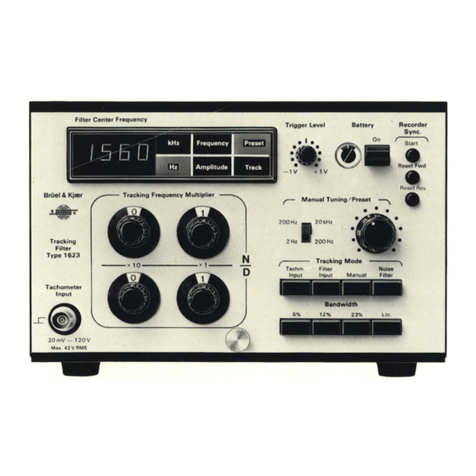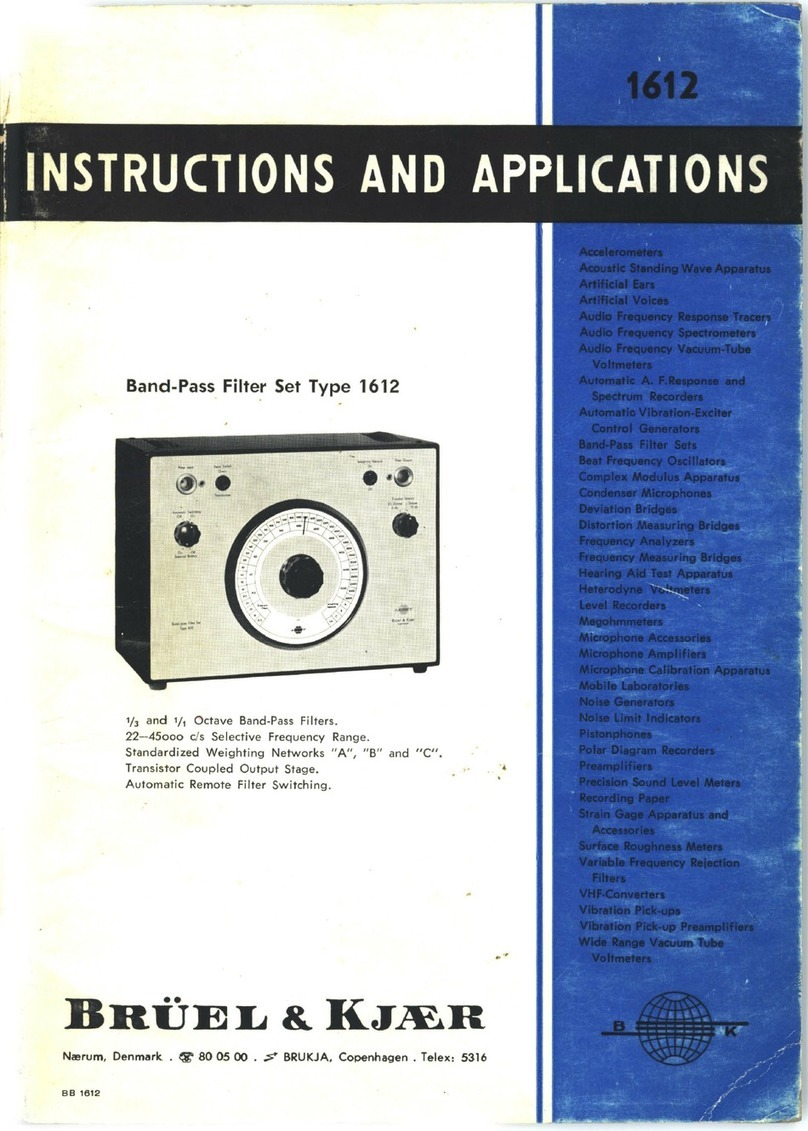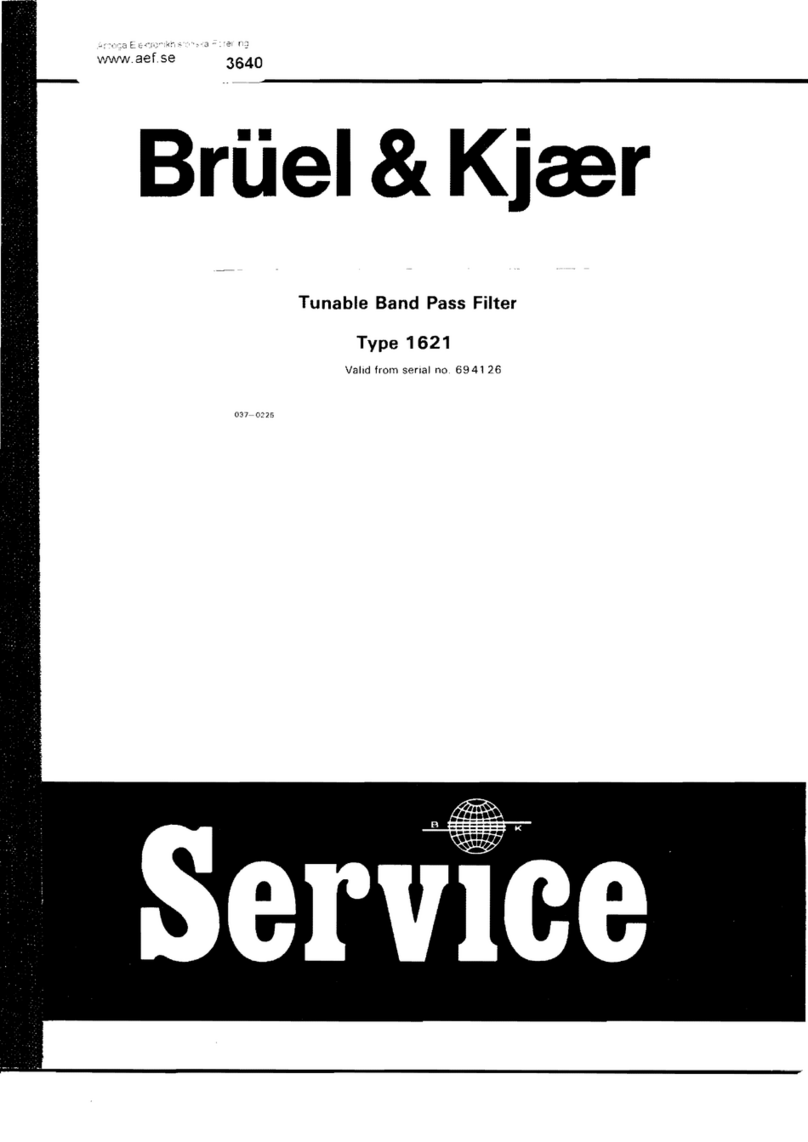
The Third-Octave and Octave
Band Pass Filters Type 1617 and
Type 1618 are key links in any in-
strumentation chain for measure-
ment and recording of the fre-
quency spectra of sound, vibration,
and electro-acoustic signals. Sev-
eral novel features have been in-
corporated, including electronic fil-
ter switching and digital indication
of the selected filter, The Band Pass
Filter Type 1618 is the basic instru-
ment, while the Type 1617 com-
bines an extended frequency range
with comprehensive control and syn-
chronisation facilities for use with
other instruments.
The Type 1618 has filter band
centre frequencies from • 2 Hz to
20 kHz that can be divided into 41
third-octave bands, or 41 overlap-
ping octave bands covering the 14
octave frequency range. It has a
built-in A-weighting network, and
there is indication given when the
level of the signal being analyzed
overloads the input section. The
Band Pass Filter has provision for fil-
ter scanning controlled by B & K Le-
vel Recorders.
The Type 1617 has filter band
centre frequencies from 2 Hz to
160 kHz that can be divided into 50
third-octave bands. It has 41 over-
lapping octave bands covering 14
octaves from 2 Hz to 20 kHz. In addi-
tion to the A-weighting, it includes
B, C, and D-weighting networks,
and there is also an input overload
indicator lamp. Filter scanning can
be controlled by a Level Recorder,
and there is a built-in interface to
the proposed IEC Digital Bus Stand-
ard to permit direct control by other
instruments and systems using this
standard. A DC ramp output can
control the X-axis of an X-Y Recor-
der, and a control circuit is included
to select averaging time programs
for use by the measuring instru-
ment.
Both Band Pass Filters will gener-
ally be used with one of the Measur-
ing Amplifiers Type 2606, Type
2607, or Type 2608, but other in-
struments such as the Frequency
Analyzer Type 2120 and the Hetero-
dyne Analyzer Type 2010 can be
employed. Connected to a B & K
Condenser Microphone, these mea-
suring instruments all form a sound
measurement system that satisfies
IEC 179 for precision sound level
meters, while Type 2606, Type
2607, and Type 2120 satisfy IEC
179A for Impulse measurement.
All three Measuring Amplifiers
can be employed with either Band
Pass Filter, so that selection of
which Measuring Amplifier to use
will largely depend on the particular
measurement application. Table 1
shows the various combinations
available, together with brief specifi-
cations, and the type of measure-
ment and analysis possible. The ba-
sic system of Type 1618 and Type
2608 is for RMS measurement in
the audio frequency range, with fil-
ter selection by Level Recorder. Opti-
mum utilisation of all measuring
modes and control possibilities is ob-
tained with a combination of Type
1617 and Type 2607, which gives
the ability to measure and analyze
in the frequency range from 2 Hz to
160 kHz, obtaining RMS and Peak
values from all commonly encoun-
tered random, quasi-random, peri-
odic, and complex waveforms. This
combination can be used together
with an Recorder such as Type
2308.
Measuring Amplifiers Band Pass Filter Type 1618 Bend Pass Filter Type 1617
General:
Freq. Range: 2 Hz — 200 kHz
Dyn. Range: 10pV — 300V
Fast and Slow averaging
Input overload warning
General:
Freq. Range: 1.4 Hz — 22 kHz
41 third-oct. bands
41 overlapping octave bands
A-weighting filter
General:
Freq. Range. 1,4 Hz — 180 kHz
50 third-oct. bands
41 overlapping octave bands
A, B. C, D-weighting filters
Averaging time programs
Control via built-in IEC interface
DC ramp for X-Y Recorder control
Type 2608 and 2121
RMS measurement
Crest factors up to 5
AC output to Level Recorders
A-weighting network
RMS measurement
20 Hz — 22 kHz
(Audio frequencies)
20 Hz— 180 kHz
Manual or remote control of filter scanning
Digital bus control of filter
scanning
Measurements can be made at lower frequencies if the
averaging ability of a Level Recorder 2307 is used
Type 2606
RMS and Peak measurement
Impulse and Hold modes
Crest factors up to 40
AC or DC outputs to Recorders
A, 8, C, D-weighting networks
Range settings shown on
meter scale
Comprehensive RMS measurement at high crest factors
20 Hz— 22 kHz
(Audio frequencies)
20Hz — 180 kHz
Manual or remote control of filter scanning
Digital bus control of filter
scanning
Measurement in Peak or Impulse Modes
1,4 Hz— 22 kHz 1.4 Hz— 180 kHz
RMS measurements can be made at lower frequencies if the
averaging ability of a Level Recorder 2307 is used
Type 2010 IRMS only),
2607, & 2120
RMS and Peak measurement
Impulse and Hold modes
Crest factors up to 5
AC or DC outputs to Recorders
50 dB logarithmic DC output
proportional to RMS Level
A, B, C, D-weighting networks
Range settings shown on meter'
scale
Measurement of RMS and Peak values of all commonly encount-
ered random, quasi-random, periodic. and complex waveforms
1.4Hz — 22 kHz 1,4 Hz— 180 kHz
Manual or remote control of filter scanning
Manual control of averaging time for 2607, 2120, or 2010
Digital bus control of filter
scanning and averaging times
for 2607 and 2120
This combination gives optimum
use of all measurement and
control facilities, including
X-Y recording (not 20101
Table 1. Band Pass Filter and Measuring Amplifier Combinations
2































